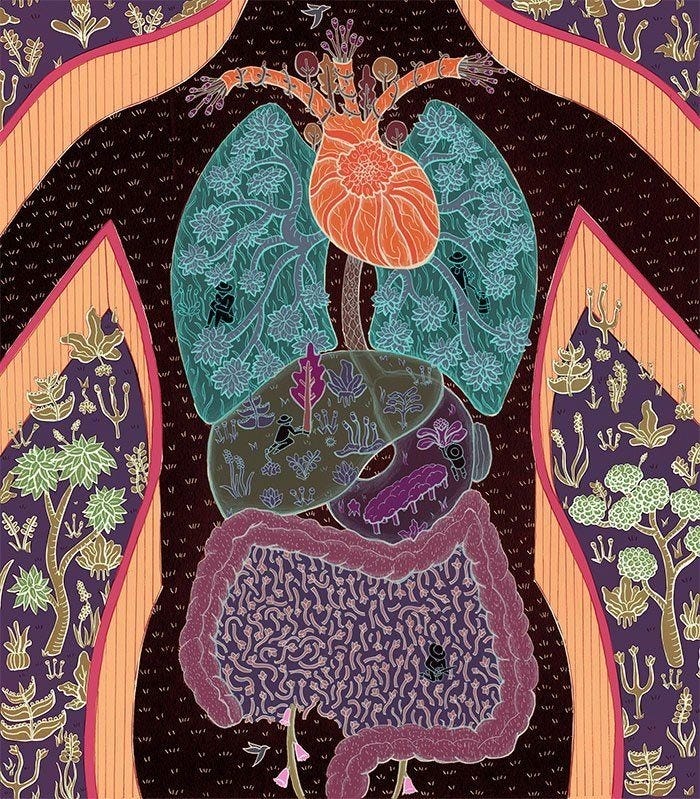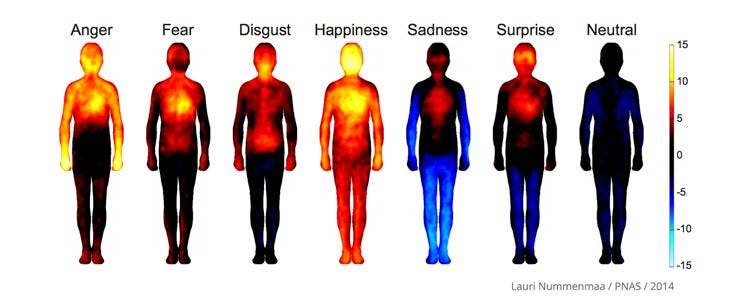This is a slight continuation of my previous post The Body’s Whispers: A Call to Spiritual Embodiment - read more there on the powerful interplay of the mind-spirit-body connection.
When we think of self-care, the first things that come to mind are usually physical. We all know what you should do to care for your body - exercise, sleep, drink water, eat greens, etc.
It is worth investigating why we don’t do those things that we know are good for us (i.e. too much else to do, erroneous invincibility, dessert is tastier than kale). You can read about additional stumbling blocks here.
But engaging in soulful self-care of the body goes beyond the obvious list. How we care for our bodies is how we care for our spiritual selves as well.
Here are a few other intentional ways to care for these mortal coils we inhabit.
Persist
Working in healthcare pays my bills. I know fantastic physicians. I also know that there are limits to their knowledge. And medical gaslighting exists. I’ve detailed my own experiences of this here. And recently trying to seek treatment for peri/menopause has reinforced for me the gaps and biases in medicine.
Frequently I encounter people who sought medical attention for something serious, only to have been dismissed and then wound up back in the hospital much worse. (The problems with the healthcare system in this country would require a different soapbox altogether). I’m here to urge you – to persist and advocate for yourself.
As a chaplain, I tell patients “You know your body better than anyone else.” If something feels off, it probably is. If the first person says it’s nothing, don’t let that dissuade you. If you have to do your research – that’s the beauty of having the internet at your fingertips. Your body is worth listening to and pain is its way of telling us something.
Also, let’s not wait until our bodies are in pain. Here is my Public Service Announcement: Do all the preventative screenings. Get your annual physical. Schedule those dental cleanings. Go for the mammograms and colonoscopies. None of these things are pleasant, but they are necessary. Of course, it’s more fun to go to the spa for self-care, but you also need to go for routine medical appointments. Please don’t make me tell you about the number of times I’ve been at a patient’s deathbed and the family tells me “they always refused to go to the doctor.”
Soften
“What can you do to make yourself 2% more comfortable right now?” I love this question that is sometimes included in meditation prompts. It’s a fantastic invitation because it seems easy enough to obtain. I might not be able to make myself 50% more comfortable – but a low single-digit percentage feels doable. Usually, when I hear it, I adjust myself on a mat, or chair, or loosen my jaw a bit. It also helps us to know what is going on with our body and connect with it.
To soften, we first have to be aware of where the tension is residing in our bodies. I suggest trying a simple body scan or a progressive muscle relaxation. The idea is to start at the top of your head working your way down your entire body to check in with any sensations your body is holding. In the progressive muscle scan, you are doing the same type of scan but also tensing up and then releasing parts of your body to get more relaxed.
John Kabat-Zinn pioneered many of these techniques and you can listen to him walk you through it here. He writes of the opportunity to meet awareness,
“If you find tension or discomfort, bring awareness to it. Let your breath meet it gently. You may find that it softens, or it may not—but either way, you are practicing awareness and acceptance.” - Full Catastrophe Living
And of the mind-body-soul benefits of such a practice,
“Learning to soften in the body can teach us how to soften in the mind—how to approach ourselves with kindness rather than judgment.” - Mindfulness for Beginners
There are a few ways you can probably soften right now:
Drop your shoulders, expanding the space between them and your ears.
Gently move your tongue down from the roof of your mouth.
Splay your fingers wide and then return them to a neutral position.
Take a deep breath into your belly or if you’re able to try to yawn.
Admire
I once heard a story about a mom who referred to her stretch marks as her “tiger stripes.” I loved this claim of the power of her body – especially when society has worked hard to tell us only certain bodies are acceptable. When I was younger, I bore witness and participated in way too many conversations among friends about “what we would change about our bodies if we could.” People more well-versed in body positivity than I could tell you how that is the fault of misogyny and internalized shame. For now, I invite you to flip that question on its head. What part of your body do you need to reclaim as strong or beautiful? How can you adore your current physical self?
Barbara Brown Taylor talks about the importance of loving our bodies as spiritual vessels in her book, An Altar in the World. She even encourages naked praying! (So scandalous!)
“There comes a time when it is vitally important for your spiritual health to drop your clothes, look in the mirror, and say, ‘Here I am. This is the body-like-no-other that my life has shaped. I live here. This is my soul’s address.” After you have taken a good look around, you may decide that there is a lot to be thankful for, all things considered. Bodies take real beatings. That they heal from most things is an underrated miracle. That they give birth is beyond reckoning.”
It might take a tremendous amount of vulnerability to connect with ourselves in this way, but it is raw, honest and real. This might just be what would help you reconnect with the sacredness of your body.
Another way we can tap into awe for our bodies is by acknowledging all the biological processes that are currently going on inside of us without our realizing it. One of my patients learned this attitude of gratitude the hard way.
Brian was a passenger in a car accident. He was banged and bruised, but the major issue was his ruptured spleen. I saw him the day after his surgery and he was marveling at having an organ operated on that he had never thought about before.
“I didn’t even know I had a spleen, or what it did. The doctor had to draw me a picture of it because I was so clueless... It makes me wonder about all the other organs that are working all the time that I don’t even know about unless something goes wrong.”
Right now, as you're reading this, your lungs are inflating as you breathe without thinking. Your heart is pumping blood throughout your body - and your spleen is filtering it. All of this is going on behind the scenes of your day. We tend to only appreciate parts of our body when they are not working.
How might you admire your body more and be grateful for all it does?
Reset
A chiropractor upon hearing what I did for a living, asked me, “What do you do after a patient visit?” I was perplexed by this question. “Umm, write a note in the patient’s chart.”
“What else?” she insisted.
“Sometimes I check in with the nurse or other providers on the patient’s care team.”
She shook her head, “No, after that.”
“Oh, well I’ll check the consult list for the next patient or usually I run to a meeting.”
She was patient with me, but I was not getting it.“What do you do for you? How do you reset yourself physically after an intense encounter?”
I had no answer. This was a revelation to me. I now ask all my students this question.
I learned to be more intentional about resetting. I do yoga poses in the elevator (when alone!) or a short breath meditation. When it’s nice out, I might go for a quick walk from one hospital entrance to another. I keep essential oils on my desk just to smell something uplifting. I drink some water, but more often coffee. There’s even been a time or two when I’ve laid on the couch in my office and rested my eyes for a few minutes!
Sometimes my calendar is packed with back-to-back meetings and there’s no time for one of these lovely reset rituals. That’s where a quick moment of silence might come in. A two-second pause before I jump into the next Zoom meeting. One deep breath before calling the next student into my office. Or some spiritual habit-stacking washing my hands and saying a prayer.
In their book Burnout: The Secret to Unlocking the Stress Cycle sister authors Emily and Amelia Nagoski write about the importance of “closing the stress cycle.” They posit that our bodies need to acknowledge that a stressful situation is over and we’ve lost the ways of doing that for ourselves. We once needed all the extra adrenaline and cortisol dumped into our bodies to do things like run away from lions chasing us – but when we reached safety, our bodies knew to return to our normal resting state. Fortunately, we are not being chased by predators on the regular, but as we exist in a continual stress cycle, our bodies don’t know how to reset ourselves when we are “safe.” There is no physical closure of collapsing to the ground, panting, thanking the heavens we avoided being a lion’s lunch.
The Nagoski’s write about the connection thusly,
“One thing we know for sure doesn’t work: just telling yourself that everything is okay now. Completing the cycle isn’t an intellectual decision; it’s a physiological shift. Just as you don’t tell your heart to continue beating or your digestion to continue churning, the cycle isn’t complete by deliberate choice. You give your body what it needs, and allow it to do what it does, in the time that it requires.”
To physically close a stress cycle, they recommend engaging in the following areas:
Movement
Breathing
Positive Social Interaction
Laughter
Affection
What might you employ to close a stress cycle for yourself today?
Feel
As a former therapist and current chaplain educator and spiritual director, I am big on feelings. If you need a refresher on what I consider a feeling – read here.
When my students or clients are confused about what they might be feeling emotionally, I invite them to consider where they feel it in their bodies.
We can feel our emotions in different bodily sensations. Consider a time when you’ve been angry. Do you feel a pit in your stomach? Does your head throb? Maybe your chest gets tight or you notice your throat close up. It can look different for everyone, but research has proven it does happen.
Here’s an image from a research study of participants identifying where they feel emotions in their bodies:
Just as our body whispers information to us in our pain, we can also access emotional intelligence. Think of the everyday sayings we have in our lexicon – “I had a gut feeling.” “I got choked up.” “My heart broke.” “They were a pain in the neck.”
Don’t underestimate the emotional impact on your body and vice versa. Sometimes our bodies are also holding feelings for us that we don’t even realize. As mentioned above, it can take some physical movement to unearth those feelings and then close that stress cycle.
I was recently on a clergywomen retreat1 where “grief yoga” was offered. If you’ve been reading here for a while, you know that I am always talking about grief! I believe that we are always grieving something at any given time.
You may not know that I also love yoga. So this offering was right up my alley. And yet, I was skeptical as the instructor passed out tissues before the class began. I’m not against crying and think tears are sacred. I cry frequently and process my feelings with professionals and colleagues all the time. Surely, I had done all the talking and crying there was to do. And yet, 30 minutes in, I was sobbing.
Before the class, I had no idea my body was still in need of processing some grief. I am convinced it was connecting with the physical self and moving through some of these tailored poses that helped me unlock something profound. As I re-read the Nagoski list of 7 recommendations to close a stress cycle, I realized this class touched every single component.
The instructor, Jillene, isn’t yet holding virtual classes, but I made her promise that she would soon! In the meantime, here is a video I insisted she record about grief yoga. (You can see me modeling some of the poses!) If you’re interested in taking a class here are some offerings from the individual who created the certification.
What can you do right now to make yourself 2% more comfortable?
Where are you holding stress in your body right now?
What medical appointment are you going to make today?
How do you reset yourself physically after an intense encounter?
What would you add to this list of soulful self-care body practices?
As always, I'd love to hear your thoughts, questions, comments and/or complaints! You can add them below and connect with me on Instagram, Facebook, LinkedIn and my website.
Related Posts:
It was a fantastic retreat and I have videos on my Instagram of the tropical locale. If you want details about the one happening next February, comment below! Also, I’ll be writing a future post about retreats in general.














A phenomenal piece! I’m also a trauma informed yoga instructor and I can’t YES this all enough!!
I love these invitations. These days I make it a ritual between clients to wash my hands, open my windows, and shake or stretch my body. It feels like a useful reset, a chance to shift the energy, and a break from the stagnation of sitting all day 😊